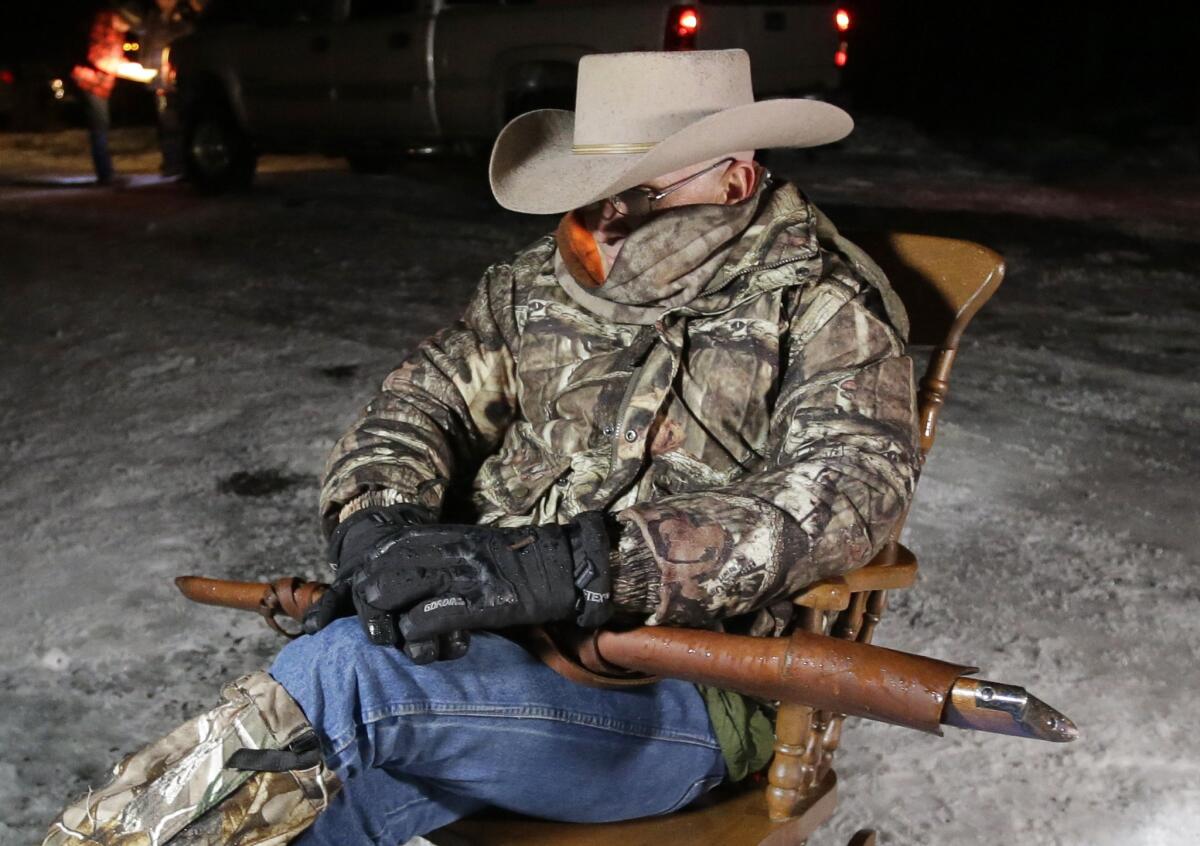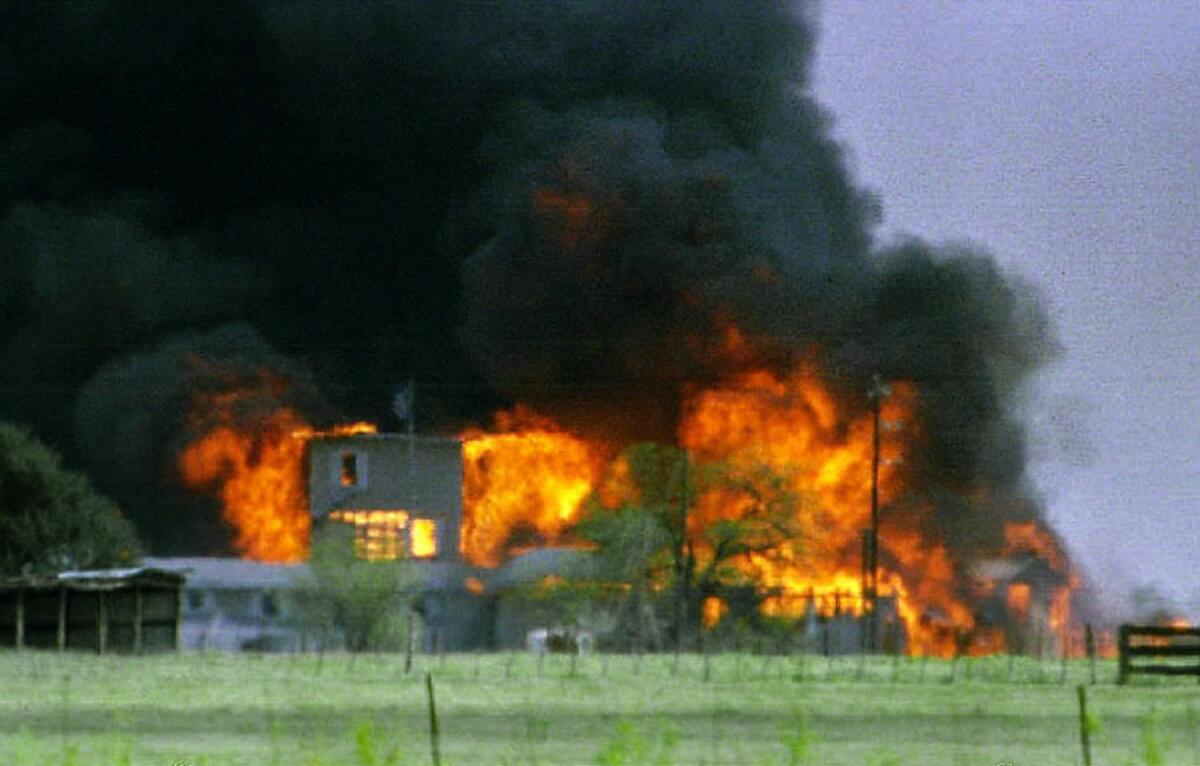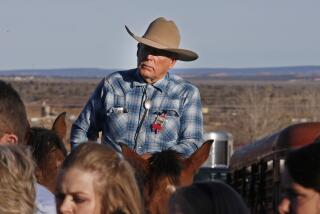After Ruby Ridge and Waco, authorities keep a low profile in Oregon

Rancher and activist LaVoy Finicum pulls guard duty at the Malheur National Wildlife Refuge near Burns, Ore.
- Share via
Reporting from BURNS, ORE. — Four days into the armed occupation of a wildlife reserve in Oregon’s rugged backcountry, and something’s still missing.
The police.
While local authorities and federal agents have kept an extraordinarily low profile as the dissatisfied ranchers and activists remain holed up in the Malheur National Wildlife Refuge headquarters, one recently retired FBI commander said he’d be shocked if law enforcement hasn’t monitored the every move of the occupiers.
Join the conversation on Facebook >>
Greg Vecchi, former chief of the FBI’s Behavioral Science Unit, said the agency is almost certainly preparing a worst-case scenario to take the occupied wildlife refuge headquarters by force, and that – following the procedures he was familiar with – had likely constructed a set of buildings that resemble the ones in Oregon and have practiced for a coordinated tactical assault.
“They have found a building or quickly put together a mock-up of the building and they’re practicing, putting role players in there to represent the people inside,” said Vecchi, who retired in 2014 and wrote his doctoral dissertation on hostage situations.
“They’re dropping helicopters, working flashbangs, coming in with [armored personnel carriers], so that if it happens, it’s kind of like the Navy SEALs did with Osama bin Laden,” he said. “Practice, practice, practice.”
But a tactical assault is an option of last resort and federal agents in recent years have taken a seemingly placid, wait ‘em out approach to potential showdowns like the one in Oregon. The more measured tactical plan was shaped by the pushback to the deadly sieges at Ruby Ridge, Idaho, and near Waco, Texas.
The downside is that authorities sometimes come away appearing to be weak -- activists get away with breaking the law, escape fines and other potential punishments
But authorities said avoiding the loss of life is the aim of a more reserved approach.
“We have enough firepower, we have enough guns, we have enough equipment and tech to take back what they’ve got,” said retired FBI agent James Wedick. “It’s better not to show up with an overwhelming appearance of force and cause something to happen.
“The approach,” he said, “is to de-escalate.”
In cases similar to what’s unfolded in Oregon’s rugged backcountry, Vecchi said the FBI sets up what agents call physical and verbal perimeters – out of sight, but observing the moves of the subjects of a siege.

This April 18, 1993, photo shows the Branch Davidian compound near Waco, Texas, in flames.
The wildlife refuge of 19 buildings about 30 miles outside Burns, Ore., was occupied Saturday by a group of activists who arrived to protest the incarceration of father-and-son ranchers who’d already spent time behind bars before a judge determined their sentences were too short.
To determine the number of people inside the compound, Vecchi said the FBI is likely using thermal imaging cameras to detect heat signatures, and will have its role-players mimicking the locations and movements of the people inside.
Crisis on a national scale draws the attention of the FBI’s Critical Incidents Response Group, which is itself a response to the deadly militia sieges of the 1990s.
In the early 1990s, the FBI had two primary teams to deal with a crisis: hostage negotiators and tactical assault teams. A natural tension existed between the groups, based on their preferred approach to ending a crisis.
When the Branch Davidians shot and killed ATF agents inside the Mount Carmel Center ranch near Waco in February 1993, the FBI arrived as if an occupying force. That, said Vecchi, was a mistake when confronting a group of extremists already deeply suspicious of the federal government.
The Waco siege ended when the FBI pumped tear gas into the building, the Branch Davidians fired on them and a massive blaze consumed the ranch, killing most of the people inside, children included.
In the aftermath of the disastrous siege, the tension between the negotiation and tactical groups’ commanders became the dominant story. Then-FBI Director Louis Freeh reorganized the bureau’s approach to crises and combined the two groups, demanding a more coordinated approach.
The first victory for Freeh’s vision was in Montana in 1996, when a group known as the Freemen held off authorities for 81 days. The siege ended peacefully.
One of the keys to that surrender, Vecchi said, was a third-party intermediary. The Freemen refused to deal with the FBI, so the agency turned to a local sheriff to help bring things to an end.
“They coached that sheriff on how to negotiate, and the [Freemen] viewed the negotiator as credible,” Vecchi said. “There was no reason to do anything else.”
In Oregon, Harney County Sheriff Dave Ward has already established himself as an opponent of the occupation, asking the people inside the refuge to pack up and go home to their families.
Retired FBI agent Dennis Franks, now living in Houston, said as he watched the situation in Oregon unfold on television that he silently thanked the bureau’s new approach. Franks was a member of the tactical assault team during the Waco siege – albeit not on the day of the deadly final assault.
He was there when the FBI established a massive perimeter, with agents from Dallas, El Paso and San Antonio responding. The overwhelming show of force was comforting after the killing of ATF agents, but the situation didn’t sit right with him.
“I had this feeling it wouldn’t go well,” he said.
The FBI cut off supplies to the group – something no agency has proposed yet in Oregon – and played loud music to try and urge them out, a 1990s tactic that also has fallen out of favor.
“Mistakes were made that were learned from,” Franks said. “And particularly in this type of situation, with anti-government protesters, showing up in massive force would only further their cause and the hysteria of people who have adopted that belief.”
MORE ON OREGON STANDOFF
Meet the cast of colorful characters in the Oregon standoff
Oregon standoff: Who’s really getting hurt by federal grazing laws?
How Oregon ranchers unwittingly sparked an armed standoff
More to Read
Sign up for Essential California
The most important California stories and recommendations in your inbox every morning.
You may occasionally receive promotional content from the Los Angeles Times.











